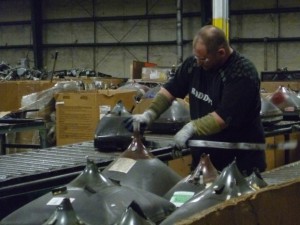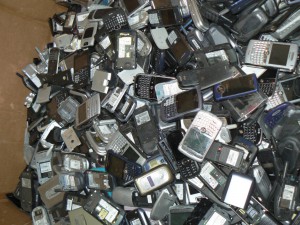Occupational Exposures at Electronic Scrap Recycling Facilities
Posted on by
Go Green! Recycle! We have all heard the call to be more environmentally conscious. However, not everyone is aware of the many health and safety hazards facing employees who handle the recycling of electronics. Many recycled electronics can contain hazardous materials such as lead, cadmium and other toxic metals. In 2011, the U.S. e-scrap recycling industry contributed approximately $20.6 billion to the U.S. economy, compared with less than $1 billion in 2002 [ISRI 2014]. The ‘e-scrap’ recycling industry is also called ‘e-waste’ or ‘e-cycle.’ This industry sector generated about 45,000 direct jobs in 2011, up from 6,000 employees in 2002, and recycled more than 4.4 million metric tons of materials in 2010 [ISRI 2014]. To better document the hazards, the National Institute for Occupational Safety and Health (NIOSH) has completed exposure evaluations at several electronics recycling facilities and conducted a survey of electronics recycling facilities across the United States.
Recent NIOSH Health Hazard Evaluations
Through the NIOSH Health Hazard Evaluation (HHE) Program we have measured employee exposures to lead, cadmium, chromium, and noisein e-scrap recycling facilities. We found that employees in facilities that process cathode ray tube (CRT) glass, including employees in areas away from where the CRT glass is processed, can be overexposed to lead and cadmium. At some facilities, we have found lead, cadmium, and other toxic metals on surfaces outside of production areas, ineffective engineering controls, and poor employee work practices such as dry sweeping (causes dust laden with toxic metals to be swept back into the air). NIOSH has also found conditions that can lead to “take-home” exposures; for example, in some e-scrap recycling facilities the employees did not have access to showers or work uniforms. As a result, employees tracked contamination through the facility and to their personal vehicles, and potentially to their homes. More information and prevention recommendations can be found in the HHE reports listed below.
- Evaluation of Occupational Exposures at an Electronic Scrap Recycling Facility
- Exposure to Hazardous Metals During Electronics Recycling at Four UNICOR Facilities
Given that results from hazard evaluations at individual sites might not be representative of an industry as a whole, we conducted a telephone survey of 47 facilities in the United States to provide a broader picture. Through the survey, we identified several types of occupational health hazards in the e-scrap recycling industry. We learned that responding facilities 1) had between 10 and 80 employees, 2) recycled a wide array of electronics, and 3) performed manual recycling processes. Some facilities had practices indicative of poor control of dust generated during recycling. The survey showed that e-scrap recycling has the potential for a wide variety of occupational exposures and that educating the industry about health and safety practices was needed to help protect employee health. More information can be found in the survey report.

NIOSH shared information from the HHEs and survey with the Institute for Scrap Recycling Industries, Incorporated (ISRI), R2 Solutions (now called Sustainable Electronics Recycling International [SERI]), and the Basel Action Network (BAN). These organizations administer the Recycling Industry Operating Standard™ (RIOS™), the Responsible Recycling Standard for Electronics Recyclers (R2,) and the e-Stewards® Standard for Responsible Recycling and Reuse of Electronic Equipment (e-Stewards®). These are voluntary certification standards for electronic recyclers. Continued efforts are needed to ensure that occupational health and safety considerations are an important component of voluntary certification programs.
Participate in a New NIOSH Study
Starting Fall 2014, NIOSH will begin a study to evaluate occupational exposures to metals and flame retardants in e-scrap recycling facilities and to recommend controls to reduce employee exposures. The HHE Program is looking for five facilities that would like to participate. We plan to observe work processes and practices, and evaluate exposure controls and employee health. During the visits, a team of industrial hygienists and medical officers will assess occupational exposures to workers at each facility, including metals (such as lead, cadmium, and indium) and flame retardants (such as polybrominated diphenyl ethers and newer alternatives). We will also evaluate engineering controls such as local exhaust ventilation, and the use of work practices and personal protective equipment at these workplaces. There is no cost to the facility to participate. The findings and recommendations from these evaluations will be shared with employer and employee representatives at each facility and will be posted on the NIOSH HHE Program website.
Seeking Feedback
NIOSH is interested in learning more about employee exposures to other harmful materials, physical hazards, or other stressors at e-scrap recycling facilities. Let us know what e-scrap health and safety hazards you think have not been well studied. We also want to learn about measures that have been effective in preventing or minimizing these workplace hazards.
Diana Ceballos, PhD, CIH, MS; Elena Page, MD, MPH
Dr. Ceballos is an Industrial Hygienist in the NIOSH Hazard Evaluations and Technical Assistance Branch in the Division of Surveillance, Hazard Evaluations and Field Studies.
Dr. Page is a medical officer in the NIOSH Hazard Evaluations and Technical Assistance Branch in the Division of Surveillance, Hazard Evaluations and Field Studies.
This work was supported in part by funding from the United States Environmental Protection Agency (Interagency Agreement No: DW-75-92357701–0; CDC/NIOSH IAA No: 12-NS12-11)
Note: The original statistics for the value to the economy, number of direct jobs, and tons of material that were posted here originally were erroneous. The statistics now posted are accurate. The correction was made on November 18, 2014.
Helpful Resources
- Occupational Safety and Health Administration Consumer Electronics
- Environmental Protection Agency. eCycling
- Health and Safety Executive. Waste Electrical and Electronic Equipment recycling (WEEE)
- The Institute of Scrap Recycling Industries, Inc.
- e-Stewards. The globally responsible way to recycling your electronics
- Responsible recycling© (R2) Certification
- Evaluation of Exposure to Metals at an Electronic Scrap Recycling Facility
- Metal Exposures in an Electronic Scrap Recycling Facility
Posted on by

